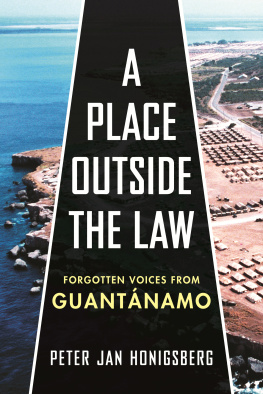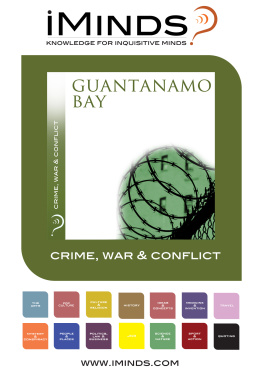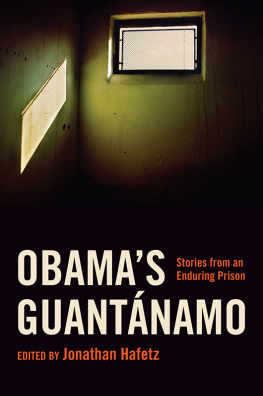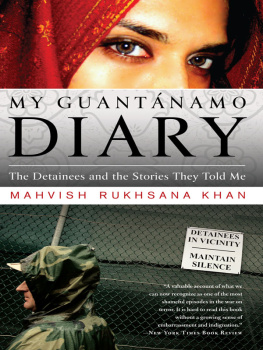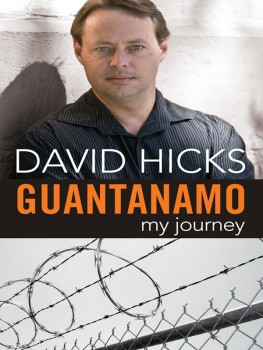Contents
Pagebreaks of the print version
Guide
ALSO BY PETER JAN HONIGSBERG
Our Nation Unhinged:
The Human Consequences of the War on Terror
Crossing Border Street:
A Civil Rights Memoir

For my wife, Mary Louise, and Christopher, Liam, Colleen, and their families
History, despite its wrenching pain,
cannot be unlived, but, if faced with courage,
need not be lived again.
MAYA ANGELOU
Theres a literary form I havent mentioned yet: the literature of witness. Offred [in The Handmaids Tale] records her story as best she can; then she hides it, trusting that it may be discovered later, by someone who is free to understand it and share it. This is an act of hope: Every recorded story implies a future reader.
MARGARET ATWOOD
AUTHORS NOTE
N early all of the quotes in this book are from interviews filmed by Witness to Guantnamo, an organization I founded in 2008 to collect and preserve the personal stories unfolding at Guantnamo Bay Naval Base. I conducted all the interviews between 2009 and 2019. Consequently, where I write that someone said or told us, I am referring to myself and the Witness to Guantnamo crew present at the interview. The people in this book gave us consent to use their interviews in this work. The interviewing process is explained in Appendix II. The full-length interviews are held in perpetuity at the Duke University Human Rights Archive in Durham, North Carolina. Duke intends to publish online nearly all of the 158 interviews we filmed across twenty countries. Duke also intends to publish transcripts of the interviews. The stories we heard need to be told, and preserved for history.
INTRODUCTION
WHEN THE PLANES HIT
O n the morning of September 11, 2001, between the hours of 7:30 and 8 a.m., nineteen men carrying metal box cutters boarded four airliners. Two of the flights were leaving from Boston; a third was from Newark; and the fourth from Dulles International in Washington, DC. Earlier that morning, most of the men cleared the walk-through metal detectors and the X-ray machines that scanned carry-on items to identify weapons. In the instances where some of the men set off the alarms on the metal detectors, those men were scanned with handheld wands. They passed through. A few men had their bags checked for explosives and also passed through.
Three of the four planes were headed for Los Angeles (LAX): American Flight 11 and United Flight 175 from Boston, and American Flight 77 from Washington, DC. United Flight 93 from Newark was bound for San Francisco (SFO). Five men boarded each plane to LAX. Only four men boarded the flight to SFO. Most of the men had purchased tickets in the front rows of the planes, either in first class or business class. A few sat in coach. One man on each plane had been trained as a pilot. The others were the muscle men.
The man intended to be the fifth on United 93 from Newark to San Francisco, Mohammed al-Qahtani, had flown into Orlando, Florida, from Dubai in early August. He was refused entry into the US and put on a plane back to Dubai. The nineteen men who boarded the planes, and al-Qahtani, who would have been the twentieth hijacker, were part of the al Qaeda terrorist organization from the Middle East. Sixteen of the men, including al-Qahtani, were from Saudi Arabia.
As each plane reached cruising altitude, the terrorists charged into the cockpits, killing the pilots and copilots. The pilot hijackers then took over the controls.
The terrorist pilot on American 11 turned the aircraft away from its designated flight path and aimed for the northern faade of the North Tower of the World Trade Center in lower Manhattan. The Twin Towers of the World Trade Center were once the tallest buildings in the world, standing over 1,300 feet. The plane hit floors ninety-three to ninety-seven of the North Tower at 8:46 a.m. Initially, the media reported that a small plane had accidentally flown into the tower.
While television news broadcast the aftermath of the incident, the terrorist piloting United 175 from the south flew the plane into floors seventy-five to eighty-five of the South Tower at 9:03 a.m. People watching the newscasts witnessed the second strike as it occurred. The video of that second strike played over and over again throughout the day, and it is available on the internet to this day.
After the second strike, it was apparent that the US was under attack. At 9:37 a.m. the third plane, American 77, flew into the western side of the Pentagon, the headquarters for the Department of Defense. This massive five-sided structure is the largest office building in the world, employing more than twenty thousand people. It is located in Arlington County, Virginia, across the Potomac River from Washington, DC.
After the suicide hijackers took control of the cockpit of United 93 bound for San Francisco, passengers learned through cell-phone conversations with friends and family members on the ground about the attacks. Several passengers decided to organize to retake control of the plane. They coordinated a plan. At 9:57 a.m., a telephone operator heard a passenger say, Lets roll.
The passenger assault began. The passengers rushed forward to try to break into the cockpit. The terrorists screamed at each other to hold back the door against the passenger siege. A passenger yelled, Lets get them! There is more screaming.
With the intent of keeping the passengers off balance, the hijacker pilot rolled the plane to the left and right and also pitched the nose up and down. However, his actions did not deter the passengers from continuing to try to storm the cockpit.
The passengers must have been close to succeeding, according to cell-phone conversations between passengers and crew in the air and family and friends on the ground, and to the cockpit recorder. Realizing that the passengers were seconds away from overpowering the terrorists, the pilot turned the control wheel hard and aimed the plane downward. As the plane fell to earth, one of the hijackers was heard shouting, Allah is the greatest! Allah is the greatest! United 93 crashed into an empty field in Shanksville, Pennsylvania, at 10:03 a.m. It was likely headed for the US Capitol or the White House.
I t was a perfect fall morning in New York City before the planes hit. The sky was a vibrant blue, with no clouds overhead. After the planes hit, the blue sky parted. Clouds of toxic smoke alternating in shades of black, white, and gray, merging with orange-gray ash, swallowed up the air. The heat of the implosion was intensetoo intense for those who had survived the strikes at the towers impact floors or above. People leaped out the tower windows to certain death to escape the unbearable heat. Those living in nearby buildings saw the bodies fall. Television viewers were not certain what they saw at first. But then they knew.
People below the impact floors rushed down the stairs to escape the burning buildings, and the toxic ash. First responders arrived to assist them. At 9:59, the South Tower buckled and collapsed. Twenty-nine minutes later, at 10:28, the North Tower buckled and collapsed.
Countless stories of rescues emerged that day and in the days that followed. Nevertheless, the heroic first responders suffered numerous casualties, as they repeatedly ran into the buildings to rescue people and dug through the burning rubble looking for anyone who was still alive. Fortunately, all but approximately one hundred people who worked below the impact zones in both buildings escaped before the towers collapsed. Twenty-five thousand people made it to safety from the towers and surrounding buildings that day.

